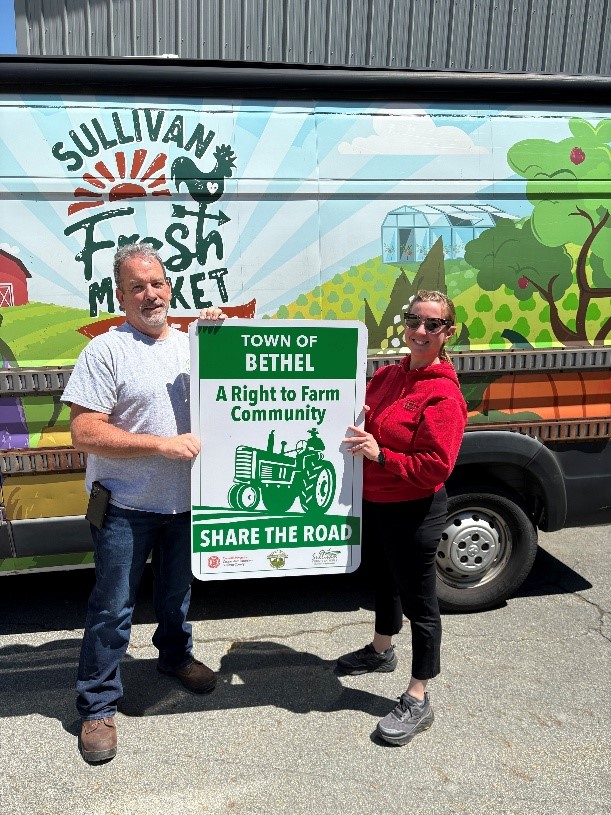
Charlie Kocher of Sullivan County's DPW Sign Shop and Melinda Meddaugh of Cornell Cooperative Extension Sullivan County hold up one of the Right to Farm signs.
Monticello, NY – To raise awareness about existing Right to Farm laws, a signage initiative has been launched across Sullivan County to remind residents of the importance of agriculture and the protections in place for local farmers.
Eleven of the 15 towns in Sullivan County – Bethel, Callicoon, Fremont, Rockland, Mamakating, Neversink, Liberty, Cochecton, Delaware, Lumberland, and Forestburgh – have enacted Right to Farm (RTF) laws.
“These laws are designed to protect farmers and promote agricultural activity, but public awareness remains low,” said Sullivan County Planning Commissioner Heather Brown. “Many residents only learn about these laws when a conflict arises with a farming neighbor, often leading to frustration on both sides.”
To bridge this gap, Cornell Cooperative Extension Sullivan County; the Sullivan County Agricultural and Farmland Protection Board; the Sullivan County Division of Planning, Community Development and Environmental Management; and local municipalities have partnered to install Right to Farm signs throughout the 11 towns. These signs serve as visual reminders of agriculture’s vital role in the county and aim to foster better understanding between farmers and non-farming residents.
“RTF laws are designed to protect and promote a farmer’s ability to operate a successful agricultural business. These laws affirm the right of farmers to engage in essential agricultural practices without undue interference or restrictions,” explained Melinda Meddaugh, Ag & Food Systems Senior Issue Leader at Cornell Cooperative Extension. “RTF laws are typically enacted at the town or county level to support and encourage farming activities. While the core purpose remains consistent – to safeguard farming operations – the specific provisions can vary from one municipality to another.
A town’s Right to Farm law allows farmers to carry out reasonable and necessary agricultural practices, provided they do not pose a threat to public health or safety. These laws are designed to support farming operations while promoting positive relationships between farmers and their neighbors.
“To help foster understanding, many RTF laws require real estate agents to inform prospective buyers that they are moving into a farming community, where activities like dust, noise, and odors may occur as part of normal agricultural operations,” added Meddaugh.
RTF laws also often include dispute resolution provisions. If a conflict arises between a farmer and a neighbor that cannot be resolved informally, either party may submit the issue to a designated committee for mediation.
Why does it matter?
“Farmers grow the food we rely on, and Right to Farm laws help protect their ability to do that work,” Commissioner Brown explained. “Agriculture isn’t always quiet or tidy, but it is a critically important piece of our community. Without these protections, farmers could face nuisance lawsuits for simply doing what’s necessary to raise livestock or grow crops.”
“Farming is already a challenging profession. From unpredictable weather to fluctuating market prices, farmers navigate constant uncertainty,” added Meddaugh. “If towns were to impose restrictive regulations, it could make farming unsustainable—leading to fewer farms and more development. Once farmland is sold to non-agricultural buyers, it’s often lost forever, replaced by pavement instead of produce.”
“That’s why it’s critical to protect farmers from unreasonable interference and ensure the public understands these laws,” she said. “Everyone in the community benefits from a strong local food system, and that means coexisting with the realities of farm life.”
So next time you’re stuck behind a tractor for a couple of miles, take a breath, advised both Meddaugh and Brown. That delay might only cost you 10 minutes – and it supports a way of life that feeds everyone. Turn up the radio, enjoy the view, and share the road with the people who grow your food!

